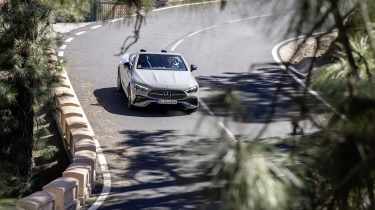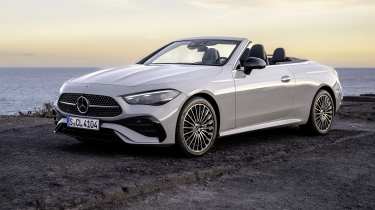Mercedes CLE Cabriolet review – two doors, four seats and six cylinders in a desirable drop-top GT
The convertible CLE melds elements of the C and E-class into a sleek package, offering a smooth, refined drive in six-cylinder form
The convertible car market is shrinking. There was a time when the four-seater cabriolet was a must have in a product planner’s portfolio; Audi (A4 and A5), BMW (3 and 4-series), Ford (Focus CC), Peugeot (307 CC), Volkswagen (Eos) and even Volvo (C70) all turned up to the party with full-size drop tops based on mainstream underpinnings, but few have survived into 2024. Mercedes-Benz used to sell two, the C and E-class cabriolets, but now there’s just one: the CLE Cabriolet.
In many ways, the CLE cab is an example of Mercedes doing what it has traditionally done best. That is, build a desirable, well appointed and easy going premium GT that doesn’t shout about its sporting pretence or beat you up with a punishing ride. It doesn’t try to be a sports car, and instead hones in on being a more relaxing alternative to BMW’s 4-series Convertible, and being the kind of car that might tempt those looking to get out of their ageing Jaguar XK Convertible. The result isn’t an especially memorable car to look at or drive, but one that you wouldn’t mind settling into for a top-down cruise on a summer’s evening.
Engine, gearbox and technical highlights
Like the coupe, the convertible CLE is a hybrid of the current C and E-class, the former providing its interior and rear end, the latter the front and mid-section, which surprisingly hasn’t resulted in some kind of headless Frankenstein's monster. The CLE is elegant and well proportioned, although you wouldn’t call it pretty or seductive.
More reviews
Four engines are offered, three of which have four cylinders and a two-litre capacity, with the 300 and 200 models running on petrol. The 200d and 220d drink from the black pump, with all models in the range being fitted with mild-hybrid tech. Then comes the CLE2450, a 3-litre straight-six petrol that, like the 300, is only available with Mercedes’ 4Matic+ variable all-wheel drive system. The 200 petrol and diesel models are rear-drive only and all are only offered with a nine-speed automatic gearbox.
At the top of the tree sits the AMG CLE53, which is again offered with four-wheel drive and a straight-six, the latter boosted to 443bhp and a matching 443lb ft of torque. It also gets AMG’s Ride Control adaptive dampers, rear-wheel steering and wide-track bodywork, as well as an electric compressor for the turbocharger to reduce lag.
Performance and 0-62mph time
While the 300 is expected to be the biggest seller in the UK, the engine lacks the smoothness and refinement this type of Benz deserves. The 200 just lacks guts, and the diesel feels very last-century.
The 450, on the other hand, adds the quality, smoothness and sense of effortless motoring that you’d expect of a six-cylinder. Its muffled tone is nicely balanced to provide a sense of occasion, the smooth spinning six hushed at tickover and becoming more vibrant at higher engine speeds.
It revs cleanly, sweeping around to 6000rpm before it starts to wind off the urgency. Upshifts are quick and seamless, the downshifts hitting home a little later than you’d expect in auto mode when braking hard into corners. In Comfort the throttle response is on the leisurely side, too, your right foot applying more pressure for not a great deal more propulsion. Switching to Sport sharpens this but the 450 never turns into a snorting sports car, preferring to make progress rather than hurling itself towards the next braking point. The jump to Sport+ is marginal in terms of engine response other than around its peak speed, where it feels more urgent.
Driving the 450 on its paddles allows you to get more from the straight-six’s potential and work with the slug of turbocharged torque to better effect, especially out of slower corners. Weighing 2080kg, the 450 will get to 62mph in 4.7sec and run to a 155mph maximum, but it doesn’t draw you into testing those claims; this breed of car isn’t about chasing lap times and winning drag races.
The CLE53 is more fiery when the straight-six comes on song. It pulls hard from the midrange, with a boom from the exhaust as each gear hits home, but there’s still a sense that the engine is working to shift a decent chunk of mass along. And despite having an AMG badge, the overall character of the CLE53 still lends itself better to a more relaxed use of the engine, without constantly battering the redline. With that said, it will tick off 62mph in 4.4sec, making it quicker than a Volkswagen Golf R.
Ride and handling
Roof down, head slowly burning under an early summer sun and the CLE is a charming way to travel. It’s an old school experience, and the CLE Cabriolet is confident, very confident, in doing what it’s designed to do.
There’s a calmness to how the 450 flows on a road, with a high level of composure, little to no body shake and a steady hand on body control when you put load through the chassis. It steers cleanly and although there’s no feel to the action you can be precise when it comes to positioning through a corner. A series of constant turns are best tackled at a slower rate of knots rather than throwing it at the apex and expecting to be able to balance it on the throttle and steering. It’s too heavy for this and very quickly becomes imprecise and a little clumsy.
Breaching its traction isn’t really on the cards; there's a soft edge to the CLE that means tyre squeal and steady state understeer are all you are going to get from it. This might lead you to ask, ‘why equip it with four-wheel drive if it requires little to no taming?’ The simple answer is the CLE’s biggest market – both coupe and cabriolet – will be North America, and the snow states insist on all-wheel drive.
The 53 is more exciting, of course, but not to the extent that it turns the CLE into a proper sports car. It still feels heavy and its controls are remote, although you can feel the four-wheel drive system subtly working the rear axle to help the car pivot through corners (still not enough to deliver a genuine sense of throttle adjustability, however). You can pick a road apart with a decent level of commitment, but there isn’t enough communication through the steering or chassis to nudge up to the limit and work the CLE harder. The brakes can start to wilt under hard use on the road, too.
It’s a bit of a shame that the AMG doesn’t bring the bite and aggression that you might expect, but the package makes more sense when you back off by a notch or two and lean into the CLE’s strengths. Then you can appreciate its strong traction, relaxed ride quality in Comfort mode and the engine’s flexibility, as well as the fact that the structure isn’t shaken to pieces on bumpy roads. It’s calm and refined too, even with the roof down, with buffeting all but eradicated and two way conversations perfectly possible and any speed.
Interior and tech
With swathes of shiny trim, ambient lighting and acres of pixels, the CLE’s cabin is more eye-catching than that of a 4-series, but we wonder whether the flashy design will age quite as well. Particularly as some of the materials don’t feel quite as premium as they look, and the complexity of the HMI can be a little overwhelming – particularly when operating it on the move.
Sharing its architecture with the C-class, there’s a sizeable central screen with far too many controls that would be easier to operate via physical switches, and beneath this are haptic controls to change driving modes, entertainment volume and access the driver assistance systems (which you’ll probably want to turn off at the start of every journey).
Mercedes has spent considerable time honing the CLE Cabriolet’s aerodynamics when its 20-layer fabric roof is stowed. A traditional removable windbreak behind the front seats is provided, but engineers have also developed an air curtain for the car, too. It’s deployable via a centre console switch and controls a windscreen header ‘spoiler’ and air-net fitted between the rear seat head restraints. When deployed the spoiler rises to deflect the airflow higher over the car, reducing the amount of turbulence that wraps around the windows and into the cabin.
In practice, there’s a slight reduction in buffeting but also an increase in wind noise from the header rail, something Mercedes admits is a consequence. Perhaps there’s a benefit in colder weather when you're more likely to feel cold air whipping around your neck, but under 30-degree sun it feels surplus to requirements.
On the plus side, the roof can be opened or closed at speeds of up to 37mph (yes, we did try), and though the cabriolet doesn’t have the hard top’s sense of integrity with the roof up, it isn’t a million miles away.
Price and rivals
The CLE Cabriolet doesn’t have many rivals, with BMW’s 4-series Convertible being the last direct competitor standing. It costs from £51,280 in 420i form compared to £53,030 for the CLE200, and stepping up to the M440i xDrive will cost you £67,400; around £3k less than the CLE450. The BMW has a more engaging character and more vibrant dynamic make-up than the Merc, but the CLE is the more elegant and laid back cabrio.
The CLE53 steps into a higher price bracket at £77,075, and if you’re willing to buy second hand, that puts it in line with 992-generation 911 Cabriolets with around 20,000 miles on the clock. Needless to say, the Porsche is a much more serious driving tool, but at the expense of the Merc’s level of comfort and usability.
Another left-field choice is Ford’s new Mustang Convertible, which starts from £59,225 and packs a wonderful naturally-aspirated V8 and the option of a manual gearbox. It’s not as plush or tech-rich as the Mercedes, but it is the more characterful car to drive, with decent long distance credentials (if you can swallow the fuel bill).





